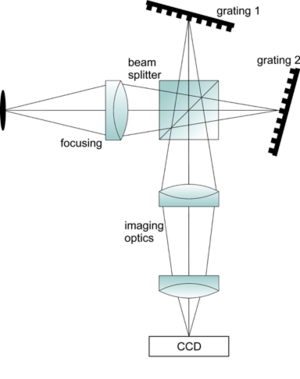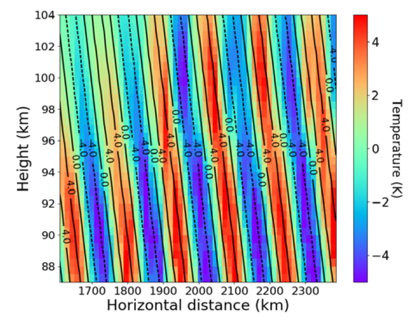Development of a Spatial Heterodyne Spectrometer for atmospheric temperature measurements
Spectrometers of the Connes type, also known as “Spatial Heterodyne Spectrometers” (SHS), are ideally suited for space applications, since they are monolithic, versatile, and robust. Together with Univ. Wuppertal and FZ Jülich, we develop an SHS for temperature measurements in the middle atmosphere, with the aim of improving weather and climate models. This requires the recording of atmospheric data on a global scale, and with high spatial and temporal resolution to be able to resolve the small scale dynamics of the atmosphere. Of particular importance are gravity waves (or: buoyancy waves), which couple different sections of the atmosphere, and need to be understood much better to improve climate projections (see Fig. 1). One innovative aspect of this project is the use of CubeSats, small satellites with a dimension of 10cm x 10cm x 60cm, which can be sent to the atmosphere in high numbers. The intention is to use a whole swarm of SHS instruments mounted on CubeSats to gain a highly resolved 3D temperature distribution with the help of tomographic techniques.

Figure 2 shows the working principle of an SHS. The setup is similar to a Michelson interferometer, with the mirrors replaced by diffraction gratings. Depending on the wavelength of the illuminating light, the outgoing wavefronts in both arms show a varying amount of tilt with respect to each other, giving rise to interference fringes on the detector characteristic for the respective wavelengths. In this way, the SHS translates the temporal frequency spectrum of the light, which is to be determined, into spatial fringe frequencies. The spectrum can then be obtained by a numerical Fourier transform. For the case at hand, the intensity ratios of eight lines of the fine structure of the oxygen atmospheric band (A-band) at about 762 nm shall be measured, allowing the reconstruction of the surrounding atmospheric temperature.
In addition, and complementary to this project, a ground based infrared system and an asymmetric SHS (DASH) for the measurement of wind speeds in the upper Thermosphere are developed.






